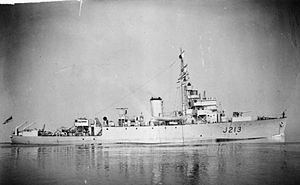Yard number 1132 Completed 24 March 1942 Construction started 15 March 1941 Builder Harland and Wolff | Ordered 15 November 1940 Laid down 15 March 1941 Commissioned 24 March 1942 Launched 22 December 1941 | |
 | ||
HMS Algerine was the lead ship of her namesake class of minesweepers built for the Royal Navy during World War II, the Algerine-class minesweepers. Initially assigned to the North Sea, she was transferred to lead the 12th Minesweeping Flotilla. The Flotilla were posted to the Mediterranean to assist with Operation Torch. In 1942, after a successful mine clearing operation off Bougie, she was torpedoed by the Italian submarine Ascianghi, causing Algerine to sink, leaving only eight survivors.
Contents
Description
Algerine displaced 850 long tons (860 t) at standard load and 1,125 long tons (1,143 t) at deep load. The ship had an overall length of 225 feet (68.6 m), a beam of 35 feet 6 inches (10.8 m) and a draught of 8 feet 6 inches (2.6 m). She was powered by Parsons geared steam turbines, driving two shafts, which gave a maximum speed of 16.5 knots (30.6 km/h; 19.0 mph).
The ship mounted one single 4-inch (102 mm) Mk V gun. Algerine had four single mounts for 20-millimetre (0.8 in) Oerlikon 20 mm autocannon, and she was fitted with two depth charge rails, and four depth charge throwers.
Career
Algerine was laid down on 15 March 1941, by Harland & Wolff, Belfast, and launched on 22 December 1941. She was the eighth ship of the Royal Navy to be named Algerine. After being completed, the ship was commissioned on 24 March 1942, and adopted by Sittingbourne due to a Warship Week campaign.
1942
Algerine joined the 9th Minesweeping Flotilla in May 1942 and began action in minesweeping, escorting, and patrolling duties on the east side of England. She was proposed as leader for the 12th Minesweeping Flotilla, which would participate in action abroad. Her sister ships from the 9th Flotilla, Alarm and Albacore, joined her, as did Acute, and Cadmus. In October, she was put forward to go to the Mediterranean to assist Operation Torch, but her departure was delayed due to repair work. The other four ships in her flotilla left for Gibraltar as escorts to a convoy. Four days after the other ships left, Algerine escorted convoy KMF1 to Oran.
In early November, she helped recover the escort destroyer Cowdray off Algiers after Cowdray was damaged by an aerial attack. On 15 November, Algerine and Alarm were positioned off Bougie, clearing mines. The mission had been successful, with 46 mines cleared; but, Algerine was torpedoed by the Italian Adua-class submarine Ascianghi, commanded by Lieutenant commander Rino Erler. The submarine had first fired two torpedoes at the middle ship in the trio, then fired another two torpedoes at the final ship, Algerine: Algerine suffered heavy casualties and sank. The converted merchant vessel Pozarica rescued 32 men, of whom only 8 survived, internal wounds killing 24. The survivors had been on a Carley raft.
Algerine's wreck lies at 1,100 ft (340 m) on the northern coast of Algeria.
